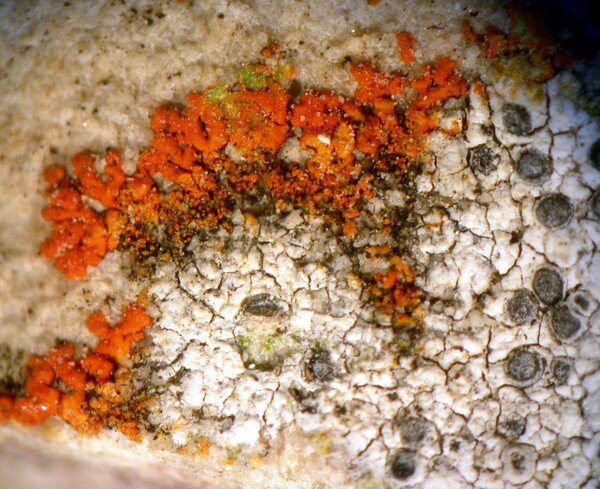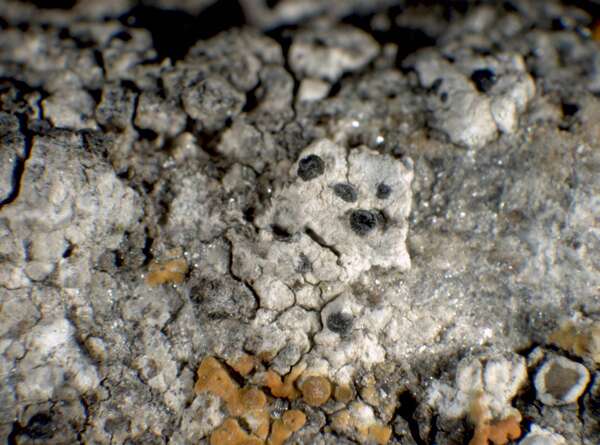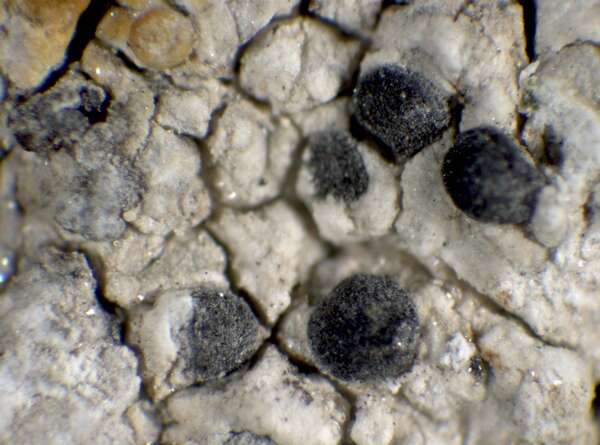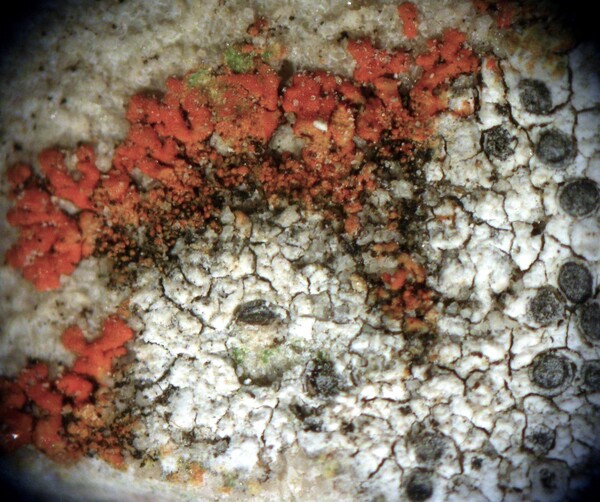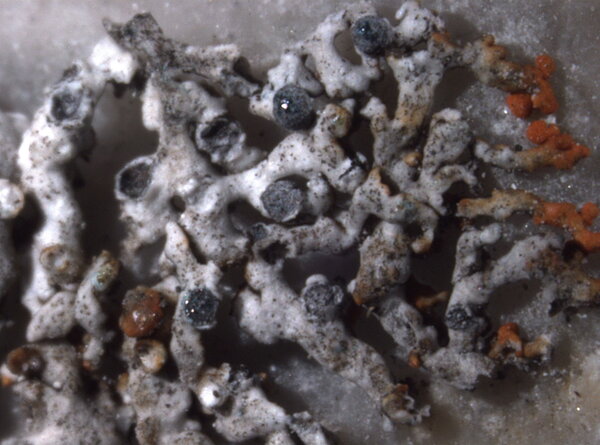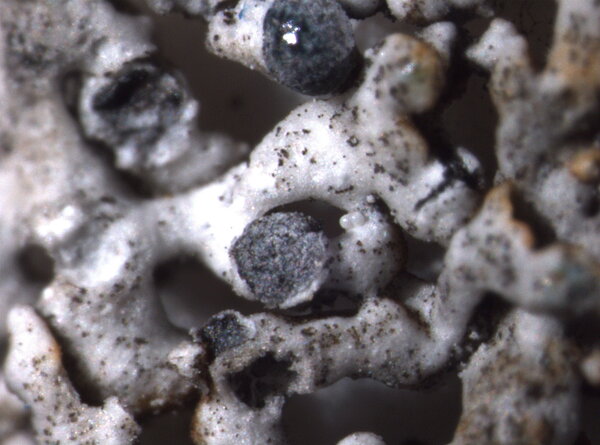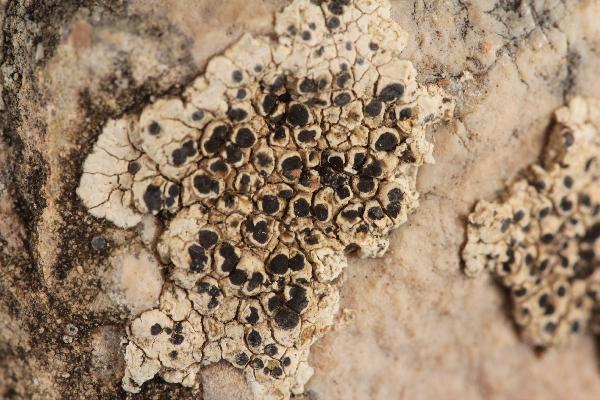Diplotomma nivale (Bagl. & Carestia) Hafellner
Hertel ex Hafellner in Hafellner & Türk, Carinthia, 2: 611, 1995. Basionym: Leciographa nivalis Bagl. & Carestia - Comm. Soc. Critt. Ital., 2: 84, 1864.
Synonyms: Buellia margaritacea (Fr.) Lynge; Buellia nivalis (Bagl. & Carestia) Hertel ex Hafellner; Diplotomma margaritaceum (Fr.) Szatala; Polyschistes nivalis (Bagl. & Carestia) Keissl.
Distribution: N - Ven (Nascimbene 2008c), TAA (Nascimbene 2004, 2008b, Nascimbene & al. 2022), Piem (Isocrono & al. 2004), Lig. C - Tosc, Umb (Genovesi & Ravera 2001, Ravera & al. 2006), Laz, Mol (Nimis & Tretiach 1999, Caporale & al. 2008), Sar. S - Si (Monte & Ferrari 1996).
Description: Thallus crustose, episubstratic, areolate, white, at first forming scattered, small, orbicular patches (1-2 mm diam.) on the thalli of other lichens, then the patches becoming confluent. Upper cortex obscurely pseudoparenchymatous, with minute calcium oxalate crystals that are insoluble in K; medulla white, I-. Apothecia lecideine, 0.3-0.7(-1.5) mm across, at first immersed, then emergent, black but whitish-pruinose at least when young, with a flat to convex disc and a very thin, soon excluded proper margin, without a pseudothalline margin. Epithecium brown; hymenium colourless, I+ blue; paraphyses simple with enlarged, pigmented apical cells; hypothecium dark brown. Asci 8-spored, clavate to cylindrical-clavate, the apical dome K/I+ dark blue with a pale, conical-pointed apical cushion (axial mass), the wall I-, but the thin outer gel I+ blue, approaching the Bacidia-type. Ascospores submuriform, brown, very thick-walled, not ornamented, straight or slightly curved, (13-)16-20(-25) x (6-)8-9(-11) µm. Photobiont chlorococcoid. Spot tests: K-, C.-, KC-, P-, UV-. Chemistry: without lichen substances. Note: on steeply inclined to vertical faces of more or less calciferous rocks in upland areas, often parasitic on crustose and foliose Teloschistaceae. I do not agree with Nordin (1996) who proposed the synonymisation of this taxon with D. alboatrum: the very different ecology suggests to separate these taxa, at least pending a thorough revision of this difficult group.
Growth form: Crustose
Substrata: rocks
Photobiont: green algae other than Trentepohlia
Reproductive strategy: mainly sexual
paras Teloschistaceae
Commonnes-rarity: (info)
Alpine belt: rather rare
Subalpine belt: rare
Oromediterranean belt: extremely rare
Montane belt: very rare
Submediterranean belt: absent
Padanian area: absent
Humid submediterranean belt: absent
Humid mediterranean belt: very rare
Dry mediterranean belt: absent
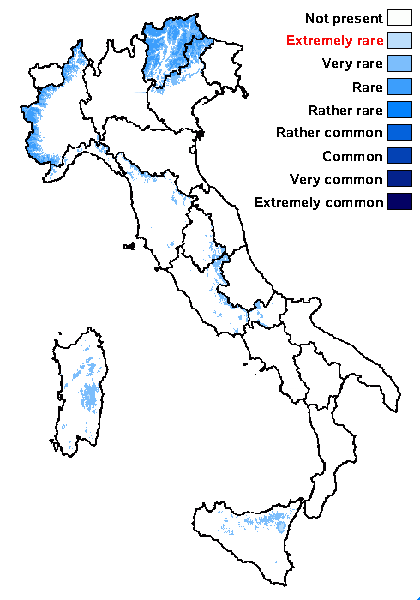
Predictive model
Herbarium samples
Growth form: Crustose
Substrata: rocks
Photobiont: green algae other than Trentepohlia
Reproductive strategy: mainly sexual
paras Teloschistaceae
Commonnes-rarity: (info)
Alpine belt: rather rare
Subalpine belt: rare
Oromediterranean belt: extremely rare
Montane belt: very rare
Submediterranean belt: absent
Padanian area: absent
Humid submediterranean belt: absent
Humid mediterranean belt: very rare
Dry mediterranean belt: absent

Predictive model
| Herbarium samples |
 INDEX FUNGORUM
INDEX FUNGORUM
 GBIF
GBIF
 DOLICHENS
DOLICHENS
